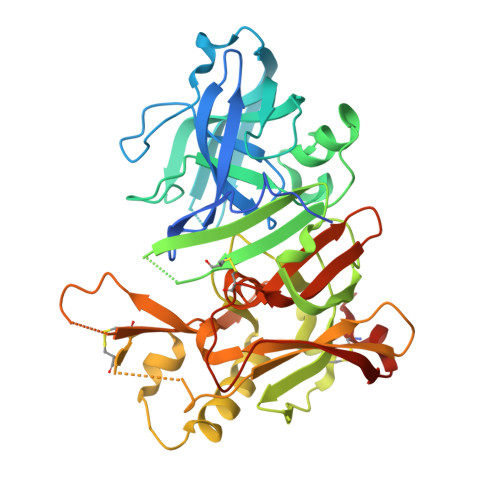Trifluoromethyl Dihydrothiazine-Based beta-Secretase (BACE1) Inhibitors with Robust Central beta-Amyloid Reduction and Minimal Covalent Binding Burden.
Anan, K., Iso, Y., Oguma, T., Nakahara, K., Suzuki, S., Yamamoto, T., Matsuoka, E., Ito, H., Sakaguchi, G., Ando, S., Morimoto, K., Kanegawa, N., Kido, Y., Kawachi, T., Fukushima, T., Teisman, A., Urmaliya, V., Dhuyvetter, D., Borghys, H., Austin, N., Van Den Bergh, A., Verboven, P., Bischoff, F., Gijsen, H.J.M., Yamano, Y., Kusakabe, K.(2019) ChemMedChem 14: 1894-1910
- PubMed: 31657130
- DOI: https://doi.org/10.1002/cmdc.201900478
- Primary Citation of Related Structures:
6JT4 - PubMed Abstract:
The β-site amyloid precursor protein cleaving enzyme 1 (BACE1, also known as β-secretase) is a promising target for the treatment of Alzheimer's disease. A pK a lowering approach over the initial leads was adopted to mitigate hERG inhibition and P-gp efflux, leading to the design of 6-CF 3 dihydrothiazine 8 (N-(3-((4S,6S)-2-amino-4-methyl-6-(trifluoromethyl)-5,6-dihydro-4H-1,3-thiazin-4-yl)-4-fluorophenyl)-5-cyanopicolinamide). Optimization of 8 led to the discovery of 15 (N-(3-((4S,6S)-2-amino-4-methyl-6-(trifluoromethyl)-5,6-dihydro-4H-1,3-thiazin-4-yl)-4-fluorophenyl)-5-(fluoromethoxy)pyrazine-2-carboxamide) with an excellent balance of potency, hERG inhibition, P-gp efflux, and metabolic stability. Oral administration of 8 elicited robust Aβ reduction in dog even at 0.16 mg/kg. Reflecting the reduced hERG inhibitory activity, no QTc prolongation was observed at high doses. The potential for reactive metabolite formation of 15 was realized in a nucleophile trapping assay using [ 14 C]-KCN in human liver microsomes. Utilizing covalent binding (CVB) in human hepatocytes and the maximum projected human dosage, the daily CVB burden of 15 was calculated to be at an acceptable value of below 1 mg/day. However, hepatotoxicity was observed when 15 was subjected to a two-week tolerance study in dog, which prevented further evaluation of this compound.
- Discovery Research Laboratory for Core Therapeutic Areas, Shionogi Pharmaceutical Research Center, 1-1 Futaba-cho 3-chome, Toyonaka, Osaka, 561-0825, Japan.
Organizational Affiliation:



















